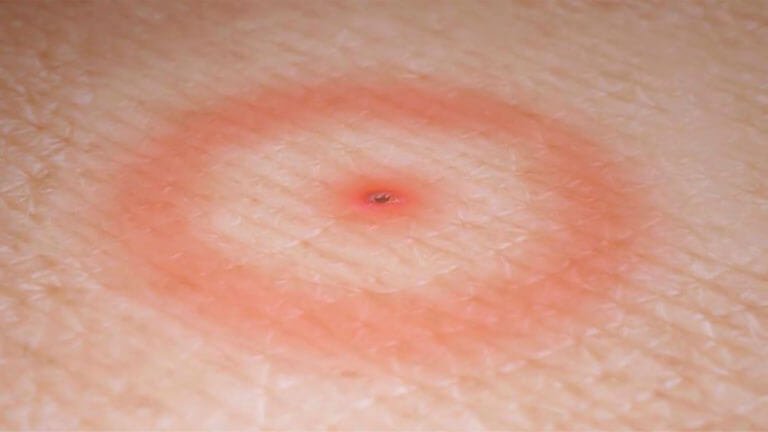Lyme Disease Breathing Problems: Signs & Relief Tips
Lyme disease can lead to breathing problems in some patients, mainly due to respiratory muscle weakness or inflammation. Prompt medical attention is crucial to manage these symptoms effectively.
Lyme disease, caused by the bite of an infected tick, affects thousands of people each year. While it primarily targets the skin, joints, and nervous system, its impact on respiratory health often goes overlooked. Patients may experience symptoms like shortness of breath or chest tightness.
These breathing difficulties arise due to various factors, including inflammation of the lungs or respiratory muscles. Recognizing these symptoms early can lead to better management and recovery. Understanding the connection between Lyme disease and breathing problems is essential for patients and healthcare providers alike. Early intervention can significantly improve quality of life for those affected.
Introduction To Lyme Disease

Lyme disease is a serious illness caused by bacteria. It spreads through the bite of infected ticks. Understanding this disease is crucial for early detection and treatment. Many people don’t know about the breathing problems linked to Lyme disease. This blog post will explore these issues in detail.
The Tick-borne Culprit
The primary cause of Lyme disease is the black-legged tick, also known as the deer tick. These ticks carry the Borrelia burgdorferi bacteria. They thrive in wooded and grassy areas. Here are some key points about these ticks:
- Size: Tiny, often smaller than a pea.
- Active Seasons: Mostly spring and summer.
- Location: Common in the northeastern U.S. and parts of Europe.
Tick bites can lead to various health problems. Early symptoms include fever, chills, and fatigue. If left untreated, Lyme disease can spread to other parts of the body.
From Bites To Breathing Issues
Many people associate Lyme disease with joint pain and fatigue. Breathing problems can also occur. These issues may not appear until weeks or months after the tick bite.
Some potential breathing issues include:
- Shortness of breath: Difficulty catching your breath.
- Coughing: Persistent or dry cough.
- Chest pain: Tightness or discomfort in the chest.
Research shows that Lyme disease can cause inflammation. This inflammation may affect the lungs and airways. Patients may experience:
| Symptom | Description |
|---|---|
| Asthma-like symptoms | Wheezing and tightness in the chest. |
| Pneumonitis | Inflammation of lung tissue. |
| Allergic reactions | Swelling or irritation in airways. |
Recognizing these symptoms early can lead to better treatment outcomes. Consult a healthcare provider if you experience any breathing issues after a tick bite.
Breathing Complications In Lyme Disease
Lyme disease can cause serious breathing problems. These issues stem from the infection’s effects on the body. Understanding these complications helps in managing symptoms effectively.
Airway Symptoms
Patients with Lyme disease may experience several airway symptoms. These can include:
- Coughing: Frequent and persistent cough.
- Wheezing: A high-pitched sound during breathing.
- Shortness of Breath: Difficulty in catching breath.
- Throat Tightness: A feeling of constriction in the throat.
These symptoms arise due to inflammation and irritation in the airways. Early recognition of these symptoms is vital for treatment.
Impact On Lung Function
Lyme disease can significantly impact lung function. The infection may lead to:
| Condition | Description |
|---|---|
| Reduced Lung Capacity | Less air intake during breathing. |
| Increased Respiratory Rate | Faster breathing due to oxygen demand. |
| Infections | Higher risk of secondary lung infections. |
These changes can lead to serious health risks. Regular check-ups are crucial for monitoring lung health.
Recognizing Lyme Disease Symptoms
Identifying Lyme disease symptoms is crucial for early treatment. Some signs can affect breathing. Recognizing these symptoms helps prevent complications.
Early Signs
Early symptoms often appear within days to weeks after a tick bite. Here are the common early signs:
- Fever: Mild to moderate fever is common.
- Chills: Feelings of cold even when warm.
- Headache: Persistent headaches can occur.
- Fatigue: Unusual tiredness is frequent.
- Muscle and Joint Pain: Aching in muscles and joints.
- Rash: A circular rash may develop, often called a “bull’s-eye.”
Recognizing these early signs helps in seeking timely medical help. Early treatment can prevent further complications.
When To Consider Breathing Problems
Breathing problems may occur as Lyme disease progresses. Watch for these signs:
| Symptom | Details |
|---|---|
| Shortness of Breath | Difficulty catching your breath during normal activities. |
| Chest Pain | Pain or tightness in the chest area. |
| Wheezing | Whistling sound during breathing. |
| Persistent Cough | A cough that doesn’t go away. |
Seek medical attention for any breathing issues. Early action is vital for better outcomes. Don’t ignore these symptoms.
Diagnosing Lyme-related Breathing Issues
Diagnosing Lyme-related breathing issues can be challenging. Symptoms often overlap with other conditions. Quick and accurate diagnosis is essential for effective treatment. Understanding the methods used for diagnosis helps patients navigate their health journey.
Medical Tests And Procedures
Doctors use various tests to diagnose Lyme disease and related breathing problems. Common tests include:
- Blood Tests: Detect antibodies to the Lyme bacteria.
- Chest X-Rays: Identify lung issues or infections.
- CT Scans: Provide detailed images of the lungs and airways.
- Pulmonary Function Tests: Measure lung capacity and airflow.
Each test helps pinpoint the cause of breathing difficulties. Accurate results guide treatment plans.
Role Of Medical History
Your medical history is crucial for diagnosis. It provides context for symptoms. Key aspects include:
- Previous Lyme Disease: Past infections can affect current health.
- Symptoms Timeline: Knowing when symptoms began aids diagnosis.
- Other Health Conditions: Existing issues may influence breathing problems.
- Exposure History: History of tick bites raises suspicion for Lyme disease.
Doctors ask detailed questions to gather essential information. This helps them make informed decisions.
| Medical Test | Purpose |
|---|---|
| Blood Tests | Detect Lyme antibodies |
| Chest X-Rays | Check for lung infections |
| CT Scans | View lung structure |
| Pulmonary Function Tests | Assess lung performance |
Understanding these diagnostic methods empowers patients. Active participation in your health journey is vital.
Managing And Treating Breathing Problems
Breathing problems can occur in Lyme disease. Effective management is crucial. Proper treatment helps improve quality of life.
Antibiotic Therapy
Antibiotics are the primary treatment for Lyme disease. They target the bacteria causing the infection. Different antibiotics may be used based on symptoms.
| Antibiotic | Duration | Common Side Effects |
|---|---|---|
| Doxycycline | 10-21 days | Nausea, rash |
| Amoxicillin | 14-21 days | Diarrhea, allergic reaction |
| Cefuroxime | 14-21 days | Headache, stomach pain |
Always follow your doctor’s advice about antibiotic use. Completing the full course is essential for effectiveness.
Supportive Care For Respiratory Symptoms
Supportive care helps ease respiratory symptoms. This includes various strategies and treatments.
- Stay Hydrated: Drink plenty of fluids to thin mucus.
- Use a Humidifier: Moist air can ease breathing.
- Practice Breathing Exercises: Deep breathing helps expand lungs.
- Monitor Air Quality: Avoid allergens and pollutants.
Consult a healthcare provider for tailored advice. They can suggest the best supportive treatments.
Preventive Measures Against Lyme Disease
Preventing Lyme disease is essential for your health. Early measures can keep you safe from ticks. Understanding how to avoid ticks can make a big difference.
Tick Avoidance Strategies
- Stay on marked trails while hiking.
- Avoid tall grass and dense bushes.
- Check for ticks after outdoor activities.
- Keep your yard tidy. Mow grass regularly.
- Remove leaf litter and brush.
Protective Clothing And Repellents
Wear protective clothing to shield your skin. Choose long sleeves and long pants. Tuck your pants into your socks.
Use insect repellents that contain DEET. Apply it to exposed skin and clothing. Follow the instructions on the label.
| Repellent Type | Concentration | Duration of Protection |
|---|---|---|
| DEET | 20-30% | Up to 6 hours |
| Picaridin | 20% | Up to 8 hours |
| Oil of Lemon Eucalyptus | 30% | Up to 6 hours |
Always check yourself and pets for ticks after being outdoors. Remove any ticks promptly using tweezers. Grasp the tick close to the skin and pull straight out.
Lifestyle Changes For Better Breathing
Lifestyle changes can improve breathing for those with Lyme disease. Simple adjustments can make a big difference. Focus on breathing exercises and dietary choices. These changes can enhance lung function and overall health.
Breathing Exercises
Breathing exercises help strengthen the lungs. They improve oxygen flow and reduce stress. Here are some effective exercises:
- Diaphragmatic Breathing: Breathe deeply from your diaphragm. Inhale through your nose, expanding your belly. Exhale slowly through your mouth.
- Pursed Lip Breathing: Inhale through your nose. Purse your lips and exhale slowly. This helps keep airways open.
- Box Breathing: Inhale for four counts. Hold for four counts. Exhale for four counts. Hold for another four counts.
Practice these exercises daily. Start with five minutes and gradually increase the time.
Dietary Adjustments
A healthy diet supports lung health. Focus on anti-inflammatory foods. These can help reduce symptoms. Here’s a list of beneficial foods:
| Food Category | Examples |
|---|---|
| Fruits | Berries, oranges, apples |
| Vegetables | Spinach, kale, broccoli |
| Healthy Fats | Olive oil, avocados, nuts |
| Whole Grains | Brown rice, quinoa, oats |
Avoid processed foods. Limit sugar and salt intake. Drink plenty of water. Staying hydrated supports lung function.
When To Seek Professional Help
Lyme disease can cause serious health issues, including breathing problems. Understanding when to seek help is crucial for recovery. Timely medical intervention can prevent complications and improve quality of life.
Monitoring Symptoms
Keep a close eye on your symptoms. Early detection can make a big difference. Note the following symptoms:
- Shortness of breath: Difficulty breathing can signal a serious issue.
- Wheezing: A high-pitched sound during breathing may occur.
- Chest pain: Any discomfort should not be ignored.
- Coughing: Persistent cough can indicate lung involvement.
Track changes in your symptoms daily. Use a journal to record:
- Date and time of symptoms.
- Duration and severity of each symptom.
- Any triggers or changes in your environment.
Choosing The Right Healthcare Provider
Selecting a healthcare provider is essential. Seek a provider experienced with Lyme disease. Consider the following:
| Criteria | Importance |
|---|---|
| Experience with Lyme disease | Understanding the disease aids in proper diagnosis. |
| Specialty in respiratory issues | Essential for managing breathing problems. |
| Positive patient reviews | Good reviews indicate a trustworthy provider. |
Ask friends or family for recommendations. Research online to find qualified professionals.
Schedule an appointment if symptoms worsen. Don’t hesitate to seek help. Your health matters.
Frequently Asked Questions
What Are Lyme Disease Breathing Issues?
Lyme disease can lead to respiratory problems, including difficulty breathing and chest pain due to inflammation.
Can Lyme Disease Cause Lung Problems?
Yes, Lyme disease may result in lung-related complications, affecting overall respiratory function and causing discomfort.
How Does Lyme Disease Affect The Lungs?
Lyme disease may cause inflammation in lung tissues, leading to symptoms like shortness of breath and coughing.
What Are The Symptoms Of Respiratory Lyme Disease?
Symptoms include persistent cough, chest tightness, wheezing, and shortness of breath, indicating possible lung involvement.
How To Treat Lyme Disease Breathing Issues?
Treatment often involves antibiotics and supportive care to manage symptoms and reduce inflammation in the respiratory system.
Conclusion
Lyme disease can lead to serious breathing problems. Understanding the symptoms is crucial for timely intervention. Early diagnosis and treatment significantly improve outcomes. If you or a loved one experience respiratory issues linked to Lyme disease, seek medical advice promptly.
Your health and well-being depend on it. Stay informed and proactive.






